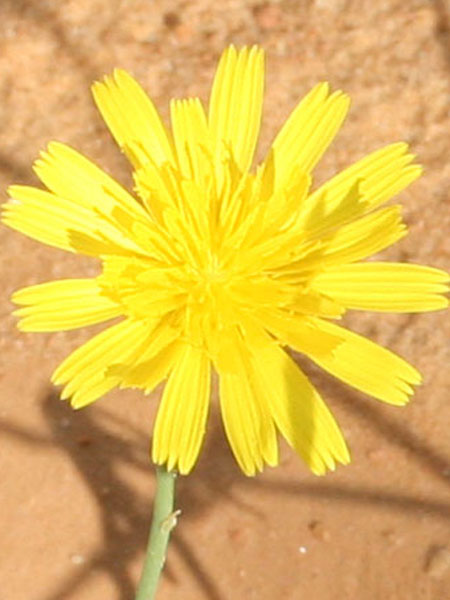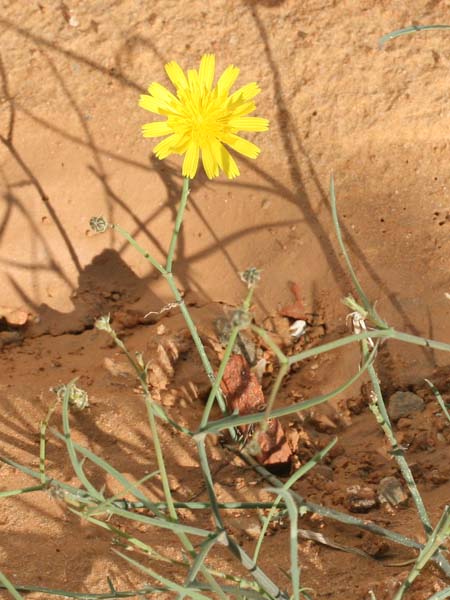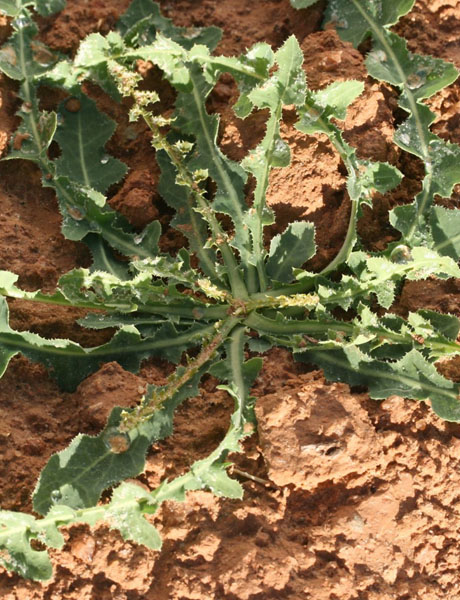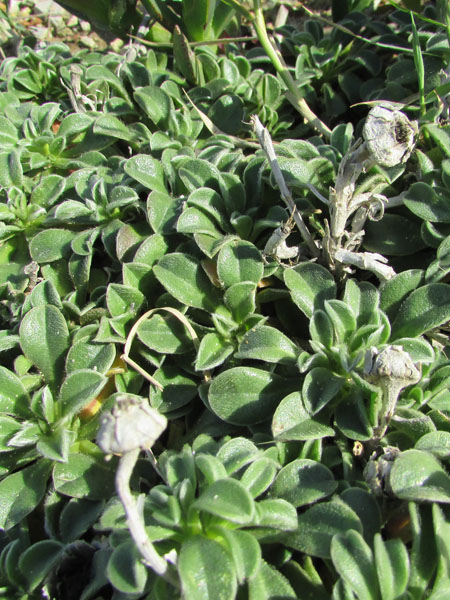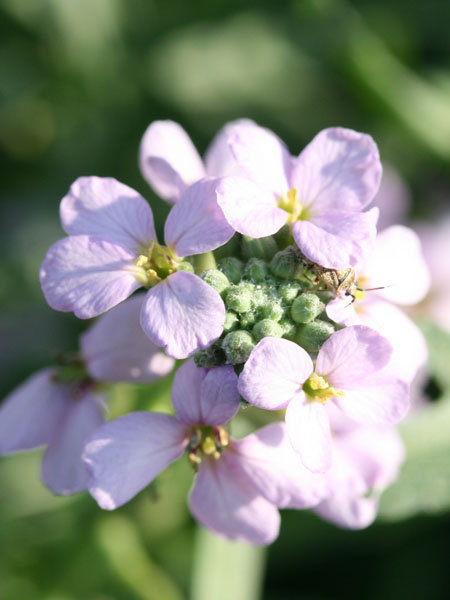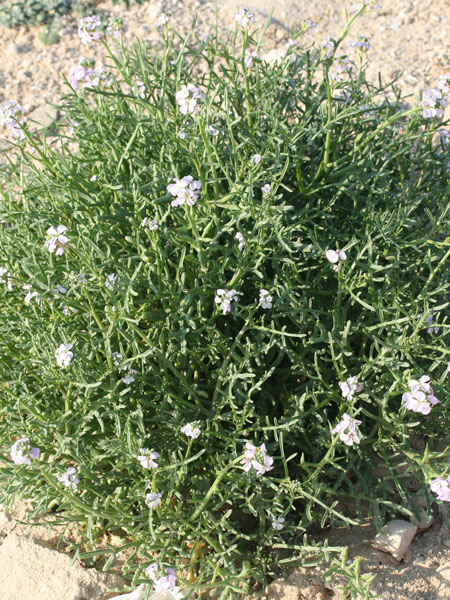Reichardia tingitana
Kingdom : Plantae / النّباتات
Division : Spermaphyta / البذريات
Clade : Magnoliophyta or Angiospermae / مستورات البذور
Class : Eudicotyledoneae / ذات الفلقتين
Order : Asterales / رتبة النّجميات
Family : Asteraceae [Compositae] / الفصيلة النجميّة أو المركّبة
Genus : Reichardia
species : tingitana
Chromosomes: 2n=16
Protologue
(L.) Roth, Bot. Abh. 35 (1787)
Synonyms
Scorzonera tingitana L., Sp. Pl., ed. 1, 791 (1753). Scorzonera orientalis L., Syst. Nat., ed. 10, 2, 1191 (1759). Picridium tingitanum (L.) Desf., Fl. Atlant. 2: 220 (1799). Picridium orientale (L.) DC. in Lam. & DC., Fl. Fr. 4: 16 (1805). Reichardia tingitana subsp. discolor sensu auct
Common names
Tunisia Arabic English French Tamazight
لبّينه
مرير
النكد الطنجي
اللّبين
نكد
مرار
مرير
حزان
جلوين
لبين
خزام
لبينة حلوان
نكد
false sowthistle
Richarde
Faux chardon
Toxic
no
Edible
yes
Latex
yes
Botanic description
Genus description
"Herbaceous plants glabrous, glaucous, lactose-like, with fistilous stems. Homogeneous, multi-lobed capitulums with numerous hermaphrodite ligules.Capitules solitary terminals on long peduncle nested at the top and bearing some scales similar to the bracts. Involucre strongly constricted above the achenes. Composed of several rows of nested bracts, membranous on the edges and clogged at the top. Naked receptacle. Akena without beak, dimorphic external prismatic, coarse, 4-5-angled, thick and crenulate, internally sterile and smooth. White egret with many smooth silks, all deciduous together.
Species description
"This plant is native to Morocco, Spain and the Canary Islands. It is a glabrous annual to perennial plant, with many branched flowering stems.
Stems low, sometimes almost zero. Leaves basic simply sinuate-toothed or pennatilobed, strongly embracing cauline. Flowers composed, yellow, discolored ligules, of black purple at the base. Fruits achenes without beak, dimorphs external prismatic, coarse, 4-5 angular, thick and crenulate, internally sterile and smooth. White egret with many smooth silks, all deciduous together.
Botanic References
Pottier-Alapetite G. (1981). Flore de la Tunisie Angiospermes –Dicotylédones (Gamopétales première partie). Imprimerie Officielle de la République Tunisienne (Eds), 1123p. www.theplantlist.org
Biology
Life form Annuel to perennial Type form Therophyte Photosynthesis C3
Phenology
Blooming
JanuaryFebruaryMarchAprilMayJuneJulyAugustSeptemberOctoberNovemberDecember
Fruiting
JanuaryFebruaryMarchAprilMayJuneJulyAugustSeptemberOctoberNovemberDecember
Map Localization
Ecology
Adaptation Salt bladder yes Invasive no
Geographical distribution
Localization Biocimatic stage Annuel pluviometry (mm) GPS Monastir (Sidi Ghedamssi, Fév.2016) Inferior semi-arid 331 35°46'58.09"N / 10°49'59.62"E
General uses
Medicinal uses
"
Colon disorders - intestinal infections - eye disease - infections. The leaves are dried, then crushed and mixed with water, and a suspension is taken via oral administration to treat colonic disorders and intestinal infections.
NOTE : This website is not that of herbal medicine and assumes no responsibility for the negative effects of the use of plants. Seek advice from a professional before using a medicinal plant.
Systems / Organs / Effects
Digestive System Eays Hypoglycemic
Dispersion mode
- Anemochory (wind)
Germination
Duration
Image
Description of the seeds
Form External structure Ornamentation Type of seed Average length of 10 seeds ± (mm) Average width of 10 seeds ± (mm) Average thickness of 10 seeds ± (mm) Average mass of 100 seeds (g)
Test results
TPC DPPH ABTS+ FRAP Year mg GAE g-1 MS CI50 g ml-1 CI50 g ml-1 CE50 g ml-1 43,95± 2,42 36,36± 1,19 48,86± 0,88 28,52± 0,15 2016 Total Phenols content(TPC), Anti-radical potentialities against (DPPH, ABTS), Ferric reducing antioxidant power(FRAP)
Molecules : ADN / Proteins
Chromosomes : 16 Uniprot NCBI
Tunisian references
Chaieb, I. (2011). Research on insecticidal plants in Tunisia: review and discussion of methodological approaches. Tunisian Journal of Plant Protection 6: 109-125.
Other references
El Alfy T, El Tantawy M, Motaal A,Gamal FZ, (2015). Pharmacological, biological study and GC/MS analysis of the essential oil of the aerial parts and the alcohol soluble fraction of the n. Hexane extract of the flowers of Reichardia tingitana l. Canadian Journal of Pure and Applied Sciences. Vol. 9, No. 1, pp. 3167-3175 Abdel Mogib, M., Abou Elzahab, M.M., Dawidar, A.M. and Ayyad, S.N.(1993). A sesquiterpene glucoside from Reichardiatingitana.Phytochemistry, 34(5):1434-1435. Daniewski, W.M., Skibicki. P., Gumuka. M., Drozdz, B., Grabarczyk, H., Boszyk, E., 1988. Sesquiterpene lactones constituents of Reichardia tingitana L. Roth and their anti-feedant activity. Acta. Soc. Bot. Pol. 57(4):539-545. Mahmoud, T., Gairola, S. (2013)Traditional knowledge and use of medicinal plants in the Eastern Desert of Egypt: a case study from Wadi El-Gemal. National ParkJournal of Medicinal Plants Studies Volume: 1, 6: 10 -17














